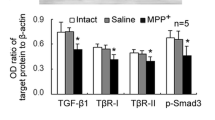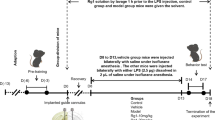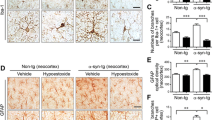Abstract
Rationale
18β-glycyrrhetinic acid (18β-GA) has been reported to have anti-inflammatory and neuroprotective effects. However, the therapeutic effect of 18β-GA in Parkinson’s disease (PD) has not been defined.
Objective
The current study aimed to evaluate the potential therapeutic effects of 18β-GA in treating PD by mitigating 1-methyl-4-phenyl-1,2,3,6-tetrahydropyridine (MPTP)-induced neurotoxicity.
Results
The study showed that 18β-GA has anti-inflammatory effects by upregulating TREM2 expression in BV2 cells, which correlates with the presence of NF-E2-related factor-2 (Nrf2). 18β-GA reduced inflammation in BV2 cells treated with 1-methyl-4- phenylpyridinium (MPP+) by enhancing TREM2 expression, which promotes an anti-inflammatory microglial phenotype. Repeated administration of 18β-GA in MPTP-treated mice led to therapeutic effects by enhancing TREM2 expression, resulting in the activation of anti-inflammatory microglia. Moreover, 18β-GA attenuated the decrease in brain-derived neurotrophic factor (BDNF) levels in both MPP+-induced BV2 cells and MPTP-intoxicated mice, indicating the involvement of BDNF in the beneficial effects of 18β-GA.
Conclusions
It is probable that activating microglial anti-inflammatory response through TREM2 expression might serve as a novel therapeutic strategy for PD. Additionally, 18β-GA seems to hold potential as a new therapeutic agent for PD.







Similar content being viewed by others

Data availability
Data will be made available on request.
References
Bathina S, Das UN (2015) Brain-derived neurotrophic factor and its clinical implications. Arch Med Sci 11:1164–1178
Baydyuk M, Xu B (2014) BDNF signaling and survival of striatal neurons. Front Cell Neurosci 8:254
Block ML, Zecca L, Hong JS (2007) Microglia-mediated neurotoxicity: uncovering the molecular mechanisms. Nat Rev Neurosci 8:57–69
Caglayan C, Kandemir FM, Ayna A, Gur C, Kucukler S, Darendelioglu E (2022) Neuroprotective effects of 18beta-glycyrrhetinic acid against bisphenol A-induced neurotoxicity in rats: involvement of neuronal apoptosis, endoplasmic reticulum stress and JAK1/STAT1 signaling pathway. Metab Brain Dis 37:1931–1940
Cao Q, Luo S, Yao W, Qu Y, Wang N, Hong J, Murayama S, Zhang Z, Chen J, Hashimoto K, Qi Q, Zhang JC (2022a) Suppression of abnormal alpha-synuclein expression by activation of BDNF transcription ameliorates Parkinson’s disease-like pathology. Mol Ther Nucleic Acids 29:1–15
Cao Q, Zou Q, Zhao X, Zhang Y, Qu Y, Wang N, Murayama S, Qi Q, Hashimoto K, Lin S, Zhang JC (2022b) Regulation of BDNF transcription by Nrf2 and MeCP2 ameliorates MPTP-induced neurotoxicity. Cell Death Discov 8:267
Chang YL, Chen CL, Kuo CL, Chen BC, You JS (2010) Glycyrrhetinic acid inhibits ICAM-1 expression via blocking JNK and NF-kappaB pathways in TNF-alpha-activated endothelial cells. Acta Pharmacol Sin 31:546–553
Chen HJ, Kang SP, Lee IJ, Lin YL (2014) Glycyrrhetinic acid suppressed NF-kappaB activation in TNF-alpha-induced hepatocytes. J Agric Food Chem 62:618–625
Dauer W, Przedborski S (2003) Parkinson’s disease: mechanisms and models. Neuron 39:889–909
Finney RS, Somers GF (1958) The antiinflammatory activity of glycyrrhetinic acid and derivatives. J Pharm Pharmacol 10:613–620
Fujita A, Fujita Y, Pu YY, Chang LJ, Hashimoto K (2020) MPTP-induced dopaminergic neurotoxicity in mouse brain is attenuated after subsequent intranasal administration of (R)-ketamine: a role of TrkB signaling. Psychopharmacology 237:83–92
Gao HM, Liu B, Zhang W, Hong JS (2003) Critical role of microglial NADPH oxidase-derived free radicals in the in vitro MPTP model of Parkinson’s disease. FASEB J 17:1954–1956
Giunti D, Parodi B, Cordano C, Uccelli A, Kerlero de Rosbo N (2014) Can we switch microglia’s phenotype to foster neuroprotection? Focus on multiple sclerosis. Immunology 141:328–339
Guan YF, Huang GB, Xu MD, Gao F, Lin S, Huang J, Wang J, Li YQ, Wu CH, Yao S, Wang Y, Zhang YL, Teoh JP, Xuan A, Sun XD (2020) Anti-depression effects of ketogenic diet are mediated via the restoration of microglial activation and neuronal excitability in the lateral habenula. Brain Behav Immun 88:748–762
Han Y, Zhang LJ, Wang QZ, Zhang DD, Zhao QY, Zhang JQ, **e L, Liu GY, You ZL (2019) Minocycline inhibits microglial activation and alleviates depressive-like behaviors in male adolescent mice subjected to maternal separation. Psychoneuroendocrino 107:37–45
He J, **ang Z, Zhu X, Ai Z, Shen J, Huang T, Liu L, Ji W, Li T (2016) Neuroprotective effects of 7, 8-dihydroxyflavone on midbrain dopaminergic neurons in MPP(+)-treated monkeys. Sci Rep 6:34339
He L, Zheng Y, Huang L, Ye J, Ye Y, Luo H, Chen X, Yao W, Chen J, Zhang JC (2022) Nrf2 regulates the arginase 1(+) microglia phenotype through the initiation of TREM2 transcription, ameliorating depression-like behavior in mice. Transl Psychiatry 12:459
Howells DW, Porritt MJ, Wong JY, Batchelor PE, Kalnins R, Hughes AJ, Donnan GA (2000) Reduced BDNF mRNA expression in the Parkinson’s disease substantia nigra. Exp Neurol 166:127–135
Huang EJ, Reichardt LF (2003) Trk receptors: roles in neuronal signal transduction. Annu Rev Biochem 72:609–642
Hussain H, Green IR, Shamraiz U, Saleem M, Badshah A, Abbas G, Rehman NU, Irshad M (2018) Therapeutic potential of glycyrrhetinic acids: a patent review (2010–2017). Expert Opin Ther Pat 28:383–398
Inoue H, Inoue K, Takeuchi T, Nagata N, Shibata S (1993) Inhibition of rat acute inflammatory paw oedema by dihemiphthalate of glycyrrhetinic acid derivatives: comparison with glycyrrhetinic acid. J Pharm Pharmacol 45:1067–1071
Kanazawa M, Ninomiya I, Hatakeyama M, Takahashi T, Shimohata T (2017) Microglia and monocytes/macrophages polarization reveal novel therapeutic mechanism against stroke. Int J Mol Sci 18(10):2135
Kang SS, Zhang Z, Liu X, Manfredsson FP, Benskey MJ, Cao X, Xu J, Sun YE, Ye K (2017a) TrkB neurotrophic activities are blocked by alpha-synuclein, triggering dopaminergic cell death in Parkinson’s disease. Proc Natl Acad Sci U S A 114:10773–10778
Kang SS, Zhang Z, Liu X, Manfredsson FP, He L, Iuvone PM, Cao X, Sun YE, ** L, Ye K (2017b) Alpha-synuclein binds and sequesters PIKE-L into Lewy bodies, triggering dopaminergic cell death via AMPK hyperactivation. Proc Natl Acad Sci U S A 114:1183–1188
Kang SS, Ahn EH, Zhang ZT, Liu X, Manfredsson FP, Sandoval IM, Dhakal S, Iuvone PM, Cao XB, Ye KQ (2018) Alpha-synuclein stimulation of monoamine oxidase-B and legumain protease mediates the pathology of Parkinson’s disease. Embo J 37(12):e98878
Kao TC, Shyu MH, Yen GC (2010) Glycyrrhizic acid and 18beta-glycyrrhetinic acid inhibit inflammation via PI3K/Akt/GSK3beta signaling and glucocorticoid receptor activation. J Agric Food Chem 58:8623–8629
Kawabori M, Kacimi R, Kauppinen T, Calosing C, Kim JY, Hsieh CL, Nakamura MC, Yenari MA (2015) Triggering receptor expressed on myeloid cells 2 (TREM2) deficiency attenuates phagocytic activities of microglia and exacerbates ischemic damage in experimental stroke. J Neurosci 35:3384–3396
Kigerl KA, Gensel JC, Ankeny DP, Alexander JK, Donnelly DJ, Popovich PG (2009) Identification of two distinct macrophage subsets with divergent effects causing either neurotoxicity or regeneration in the injured mouse spinal cord. J Neurosci 29:13435–13444
Lefaki M, Papaevgeniou N, Tur JA, Vorgias CE, Sykiotis GP, Chondrogianni N (2020) The dietary triterpenoid 18alpha-glycyrrhetinic acid protects from MMC-induced genotoxicity through the ERK/Nrf2 pathway. Redox Biol 28:101317
Li CX, Zhao B, Lin CZ, Gong ZP, An XX (2019) TREM2 inhibits inflammatory responses in mouse microglia by suppressing the PI3K/NF-kappa B signaling. Cell Biol Int 43:360–372
Liberatore GT, Jackson-Lewis V, Vukosavic S, Mandir AS, Vila M, McAuliffe WG, Dawson VL, Dawson TM, Przedborski S (1999) Inducible nitric oxide synthase stimulates dopaminergic neurodegeneration in the MPTP model of Parkinson disease. Nat Med 5:1403–1409
Liu W, Taso O, Wang R, Bayram S, Graham AC, Garcia-Reitboeck P, Mallach A, Andrews WD, Piers TM, Botia JA, Pocock JM, Cummings DM, Hardy J, Edwards FA, Salih DA (2020) Trem2 promotes anti-inflammatory responses in microglia and is suppressed under pro-inflammatory conditions. Hum Mol Genet 29:3224–3248
Luk KC, Kehm V, Carroll J, Zhang B, O’Brien P, Trojanowski JQ, Lee VM (2012) Pathological alpha-synuclein transmission initiates Parkinson-like neurodegeneration in nontransgenic mice. Science 338:949–953
Mahmoud AM, Hussein OE, Hozayen WG, Abd El-Twab SM (2017) Methotrexate hepatotoxicity is associated with oxidative stress, and down-regulation of PPARgamma and Nrf2: Protective effect of 18beta-Glycyrrhetinic acid. Chem Biol Interact 270:59–72
Miron VE, Boyd A, Zhao JW, Yuen TJ, Ruckh JM, Shadrach JL, van Wijngaarden P, Wagers AJ, Williams A, Franklin RJM, Ffrench-Constant C (2013) M2 microglia and macrophages drive oligodendrocyte differentiation during CNS remyelination. Nat Neurosci 16:1211–1218
Mizui T, Ishikawa Y, Kumanogoh H, Kojima M (2016) Neurobiological actions by three distinct subtypes of brain-derived neurotrophic factor: multi-ligand model of growth factor signaling. Pharmacol Res 105:93–98
Mohammadi M, Manaheji H, Maghsoudi N, Danyali S, Baniasadi M, Zaringhalam J (2020) Microglia dependent BDNF and proBDNF can impair spatial memory performance during persistent inflammatory pain. Behav Brain Res 390:112683
Molina-Holgado F, Doherty P, Williams G (2008) Tandem repeat peptide strategy for the design of neurotrophic factor mimetics. CNS Neurol Disord Drug Targets 7:110–119
Neumann H, Takahashi K (2007) Essential role of the microglial triggering receptor expressed on myeloid cells-2 (TREM2) for central nervous tissue immune homeostasis. J Neuroimmunol 184:92–99
Ouchi Y, Yoshikawa E, Sekine Y, Futatsubashi M, Kanno T, Ogusu T, Torizuka T (2005) Microglial activation and dopamine terminal loss in early Parkinson’s disease. Ann Neurol 57:168–175
Palasz E, Wysocka A, Gasiorowska A, Chalimoniuk M, Niewiadomski W, Niewiadomska G (2020) BDNF as a promising therapeutic agent in Parkinson’s disease. Int J Mol Sci 21(3):1170
Porras G, Li Q, Bezard E (2012) Modeling Parkinson’s disease in primates: the MPTP model. Cold Spring Harb Perspect Med 2:a009308
Sconce MD, Churchill MJ, Moore C, Meshul CK (2015) Intervention with 7,8-dihydroxyflavone blocks further striatal terminal loss and restores motor deficits in a progressive mouse model of Parkinson’s disease. Neuroscience 290:454–471
Seroogy KB, Lundgren KH, Tran TM, Guthrie KM, Isackson PJ, Gall CM (1994) Dopaminergic neurons in rat ventral midbrain express brain-derived neurotrophic factor and neurotrophin-3 mRNAs. J Comp Neurol 342:321–334
Stecanella LA, Bitencourt APR, Vaz GR, Quarta E, Silva Junior JOC, Rossi A (2021) Glycyrrhizic acid and its hydrolyzed metabolite 18beta-glycyrrhetinic acid as specific ligands for targeting nanosystems in the treatment of liver cancer. Pharmaceutics 13(11):1792
Stefani A, Pierantozzi M, Cardarelli S, Stefani L, Cerroni R, Conti M, Garasto E, Mercuri NB, Marini C, Sucapane P (2022) Neurotrophins as therapeutic agents for Parkinson’s disease; new chances from focused ultrasound? Front Neurosci 16:846681
Tang R, Cao QQ, Hu SW, He LJ, Du PF, Chen G, Fu R, **ao F, Sun YR, Zhang JC, Qi Q (2021) Sulforaphane activates anti-inflammatory microglia, modulating stress resilience associated with BDNF transcription. Acta Pharmacol Sin 43(4):829–839
Tang Y, Le W (2016) Differential roles of M1 and M2 microglia in neurodegenerative diseases. Mol Neurobiol 53:1181–1194
Teng HK, Teng KK, Lee R, Wright S, Tevar S, Almeida RD, Kermani P, Torkin R, Chen ZY, Lee FS, Kraemer RT, Nykjaer A, Hempstead BL (2005) ProBDNF induces neuronal apoptosis via activation of a receptor complex of p75NTR and sortilin. J Neurosci 25:5455–5463
Thakur P, Breger LS, Lundblad M, Wan OW, Mattsson B, Luk KC, Lee VMY, Trojanowski JQ, Bjorklund A (2017) Modeling Parkinson’s disease pathology by combination of fibril seeds and alpha-synuclein overexpression in the rat brain. Proc Natl Acad Sci U S A 114:E8284–E8293
Tu B, Liang J, Ou Y, Zhang X, Zheng W, Wu R, Gan L, Li D, Lu Y, Wu J, David Hong W, Zhang K, Wu P, ** J, Wong WL (2022) Novel 18beta-glycyrrhetinic acid derivatives as a two-in-one agent with potent antimicrobial and anti-inflammatory activity. Bioorg Chem 122:105714
Wang CY, Kao TC, Lo WH, Yen GC (2011) Glycyrrhizic acid and 18beta-glycyrrhetinic acid modulate lipopolysaccharide-induced inflammatory response by suppression of NF-kappaB through PI3K p110delta and p110gamma inhibitions. J Agric Food Chem 59:7726–7733
Wu DC, Teismann P, Tieu K, Vila M, Jackson-Lewis V, Ischiropoulos H, Przedborski S (2003) NADPH oxidase mediates oxidative stress in the 1-methyl-4-phenyl-1,2,3,6-tetrahydropyridine model of Parkinson’s disease. Proc Natl Acad Sci U S A 100:6145–6150
**ao Y, Xu J, Mao C, ** M, Wu Q, Zou J, Gu Q, Zhang Y, Zhang Y (2010) 18Beta-glycyrrhetinic acid ameliorates acute propionibacterium acnes-induced liver injury through inhibition of macrophage inflammatory protein-1alpha. J Biol Chem 285:1128–1137
Yamaguchi H, Noshita T, Yu T, Kidachi Y, Kamiie K, Umetsu H, Ryoyama K (2010) Novel effects of glycyrrhetinic acid on the central nervous system tumorigenic progenitor cells: induction of actin disruption and tumor cell-selective toxicity. Eur J Med Chem 45:2943–2948
Yan J, Zhang Y, Wang L, Li Z, Tang S, Wang Y, Gu N, Sun X, Li L (2022) TREM2 activation alleviates neural damage via Akt/CREB/BDNF signalling after traumatic brain injury in mice. J Neuroinflammation 19:289
Zhang W, Wang T, Qin L, Gao HM, Wilson B, Ali SF, Zhang W, Hong JS, Liu B (2004) Neuroprotective effect of dextromethorphan in the MPTP Parkinson’s disease model: role of NADPH oxidase. FASEB J 18:589–591
Zhang Y, Yang S, Zhang M, Wang Z, He X, Hou Y, Bai G (2019) Glycyrrhetinic acid improves insulin-response pathway by regulating the balance between the Ras/MAPK and PI3K/Akt pathways. Nutrients 11(3):604
Zhang JQ, Rong PJ, Zhang LJ, He H, Zhou T, Fan YH, Mo L, Zhao QY, Han Y, Li SY, Wang YF, Yan W, Chen HF, You ZL (2021) IL4-driven microglia modulate stress resilience through BDNF-dependent neurogenesis. Sci Adv 7(12):eabb9888
Zhou XL, Spittau B, Krieglstein K (2012) TGF beta signalling plays an important role in IL4-induced alternative activation of microglia. J Neuroinflamm 9:210
Funding
This work is supported by the National Science Foundation of China (82204786 to WY, 81973748, 82174278 to JC, 81973341 to QQ, and 82271563 to JZ), Huang Zhendong Research Fund for Traditional Chinese Medicine of **an University (201911 to JC), Natural Science Foundation of Guangdong Province of China (2022A1515012512 to JZ), and the Medical Joint Fund of **an University.
Author information
Authors and Affiliations
Contributions
WY, JC, and QQ designed the research and wrote the manuscript. HYL performed the behavior test, qPCR assay, western blotting assay, immunofluorescence staining, and ELSA assay and analyzed the data. CSZ examined the levels of Nrf2 protein in the cytosol and nuclear fractions. LJH and ZFL assisted with the experiments and analyzed the data. JZ revised the manuscript. All authors reviewed the manuscript.
Corresponding authors
Ethics declarations
Conflict of interest
The authors declare no competing interests.
Additional information
Publisher's note
Springer Nature remains neutral with regard to jurisdictional claims in published maps and institutional affiliations.
Supplementary Information
Below is the link to the electronic supplementary material.
Rights and permissions
Springer Nature or its licensor (e.g. a society or other partner) holds exclusive rights to this article under a publishing agreement with the author(s) or other rightsholder(s); author self-archiving of the accepted manuscript version of this article is solely governed by the terms of such publishing agreement and applicable law.
About this article
Cite this article
Luo, H., Zhang, C., He, L. et al. 18β-glycyrrhetinic acid ameliorates MPTP-induced neurotoxicity in mice through activation of microglial anti-inflammatory phenotype. Psychopharmacology 240, 1947–1961 (2023). https://doi.org/10.1007/s00213-023-06415-6
Received:
Accepted:
Published:
Issue Date:
DOI: https://doi.org/10.1007/s00213-023-06415-6



